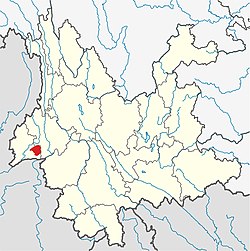Chiefdom of Mangshi
Chiefdom of Mangshi 芒市土司 | |||||||||
|---|---|---|---|---|---|---|---|---|---|
| 1443–1955 | |||||||||
 Territory in modern Yunnan | |||||||||
| Status | Native Chiefdom of China | ||||||||
| Capital | Mangshi | ||||||||
| Common languages | Tai Nuea language | ||||||||
| Government | Monarchy | ||||||||
| Tusi | |||||||||
• 1443–1459 | Fang Dingzheng (first) | ||||||||
• 1948–1955 | Fang Yulong (last) | ||||||||
| History | |||||||||
• Established | 1443 | ||||||||
• Disestablished | 1955 | ||||||||
| |||||||||
| Today part of | |||||||||
The Chiefdom of Mangshi, officially Mangshi Yuyi Zhangguansi and Mangshi Anfusi was a Dai autonomous Tusi chiefdom in the west of Yunnan, China from 1443 to 1955. In 1443, Ming dynasty established Mangshi Yuyi Zhangguansi (芒市御夷长官司) because Mangshi chief made a contribution in Luchuan–Pingmian campaigns, and then upgraded to Mangshi Anfusi (芒市安抚司) in 1640. Chiefdom of Mangshi has an absolute dictatorship in politics, military, economy at the territory, and use the rule of primogeniture.[1]
In Republic of China period, the central government used many of method try to abolish chiefdom of Mangshi, for example, established a direct control government "Luxi Administrate Bureau" (潞西设治局).[1] But chiefdom of Mangshi associate with other chiefdoms to counteractant the abolishment. At its worst, chiefdoms had a consideration for independence from China. Finally, the central government compromised with chiefdoms.[2]
After People's Republic of China controlled this area, the central government initiated the Chinese Land Reform Movement. Chiefdom of Mangshi lost his power and land, finally abolished in 1955.[3]
References
- ^ a b 云南省潞西县志编纂委员会 (1993). 潞西县志 [Annals of Luxi County] (in Chinese). Kunming: Yunnan Education Publishing House. ISBN 7-5415-0685-0.
- ^ 王春桥 (2015). "土司存废与国家统一(1944~1948)" [Maintenance or abolishment of Tusi chieftain system and unification of China (1944-1948)]. Journal of Yunnan Minzu University (Social Sciences) (in Chinese). 32 (1): 103–108. doi:10.13727/j.cnki.53-1191/c.2015.01.015.
- ^ 德宏史志编委会办公室 (1986). 德宏史志资料 第七集 [Annals material of Dehong, Volume 7] (in Chinese). Mangshi: Dehong Nationalities Publishing House.
